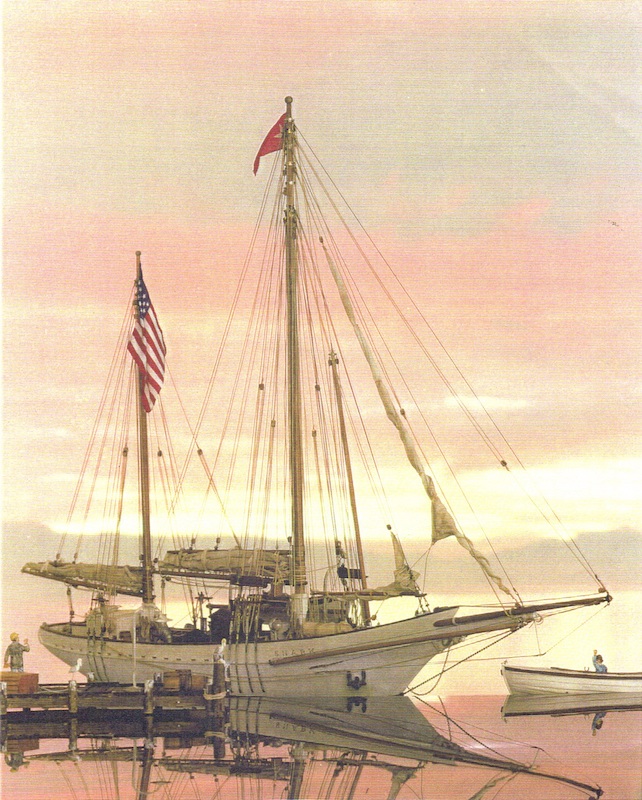In 1906, Jack London announced he was planning a trip on a boat – the Snark – he was to build and do blue-water sailing on a round-the-world cruise. (The Snark was named after one of Lewis Carroll’s nonsense poems.)
“‘Honolulu first,’ said London yesterday. ‘After that we are not very definite. Everybody’s in good health, the bourgeoise tradesmen have finally freed us, the boat is staunch, the weather fine. What more a man wants I don’t know.’”
“‘Meet me in Paris,’ called Mrs. Jack London back through the megaphone as the boat disappeared. ‘Isn’t it glorious? Good-by, everybody!” [April 23, 1907] Jack and his wife Charmian came to the Islands twice, 1907-09 & 1915-16.
Later, Charmian wrote of Jack London’s impression of the Islands, “Jack, with his unquestionable love of natural beauty,
was ever impressed with man’s lordly harnessing of the outlaw, Nature, leading her by the mouth to perform his work upon earth.”
“‘’Do you get the splendid romance of it?’ he would say. ‘Look what these engineers have done – reaching out their hands and gathering and diverting the storm wastage of streams over the edge of this valley thousands of feet here in the clouds. …”
“[O]ne day, riding in a drizzle, Jack and I happened upon the broad, steep trail of the 2500-foot eastern scarp, into Waipio, and mushed through its mud down into a sunnier level, meeting strings of ascending mules laden with garden produce.”
“An old chronicler referred to the condition of the ‘roads’ hereabout as ‘embarrassing.’ Our horses tried very fractiously to refuse the descent.”
“This was one of the prettiest little adventures we two ever had together, dropping into the sequestered vale that opened wondrously as we progressed to the lovely banks of a wooded river that wound to the sea, widening to meet the surf that thundered upon a two-mile shingle.”
“On the banks of the stream we could see wahines at their washing, and hear the ringing sweet voices of children at play-survivors of a once thick population, as evidenced by remains that are to be found of fish-ponds, taro-patches, and the like. Here the last Hawaiian tapa cloth was made.”
“That same chronicler says: ‘There was something about that valley so lovely, so undisturbed … it seemed to belong to another world, or to be a portion of this into which sorrow and death had never entered.’”
“At the head of this great break in the coast nestles the half-deserted, half-ruined village of Waipio, and behind it there wedges into the floor of the valley a tremendous rock bastion veiled in waterfalls to its mid-hidden summit.”
“A second river curved from beyond its feet, and joined the one that flowed into the sea. We rode on across reedy shallows to a pathway once sacred to the sorcerers, kahunas, the which no layman then dared to profane with his step.”
“Only approaching twilight held us back from the beach trail that leads to a clump of tall coconuts, marking the site of a onetime important temple of refuge in this section of Hawaii, Puuhonua, built as long ago as the thirteenth century by a Kauai king.”
“There is reason to believe that there were several lesser temples in the neighborhood. They do say that Kamehameha the Great was born here in Waipio.”
“One would like to think that first seeing the light of day in so superlatively grand and beautiful a vale might make for greatness!”
“That day, moving along the bases of the cloud-shadowed precipices, we planned happily how we should some day come here, restore one of the abandoned cottages and its garden, and live for a while without thought of time.”
“What a place for quietude and work!”
“For once Jack seemed to welcome the idea of such seclusion and repose. Little as he ever inclined toward folding his pinions for long, Hawaii stayed them more than any other land.”
“‘You can’t beat the Ranch in California – it’s a sweet land,’ he would stanchly defend, ‘but I’d like to spend a great deal of my time down here.’”
“We bemoaned the weather that prevented us from climbing the zig-zag stark above our heads into Waimanu.” (London, Our Hawaii)



































